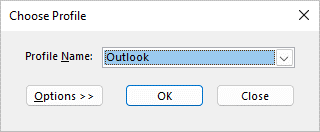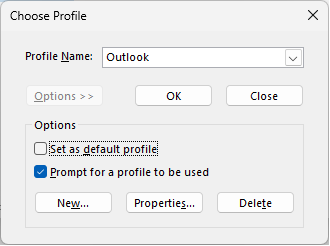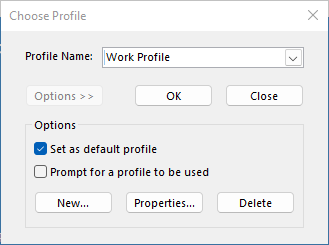An email profile is made up of email accounts, data files, and information about where your email is stored.
What is an email profile?
Email profiles are what Outlook uses to remember which email accounts you use and where the data for each account is stored. Each profile provides Outlook with the following information:
-
What account information to use This information includes the user name, display name, email server name, and Internet service provider (ISP) account password.
-
Where the email data is delivered and stored In Outlook, data is delivered and stored either on the email server or a in .pst file on your computer. This data includes rules, messages, contacts, calendars, notes, tasks, journals, Search Folders, and other settings.
Outlook email profiles are stored in the Windows registry. When Outlook starts, it retrieves the profile information from the registry.
When you run Outlook for the first time, a startup wizard guides you through the process of creating a new profile. The profile thus created runs whenever you start Outlook. Most people maintain only one profile — however, you might sometimes find it useful to have more than one. For example, you might want to use one profile for work mail and a second profile for personal mail. Also, if other people use the same computer that you do, their accounts and settings can be kept in separate profiles that have different names.
You cannot use passwords to protect Outlook profiles. To help protect your Outlook data from intrusion by other people, you should use a password-protected Windows user account.
Important: You cannot switch from one email profile to another while Outlook is running.
A basic profile consists of one or more email accounts and a storage file. A private individual might have an Internet email account, such as a POP3 account, while corporate workers might have a Microsoft Exchange account. Accounts of other types (including IMAP4 and HTTP accounts) can be added to any profile, and so can additional storage files (such as an Archive.pst file for keeping older messages). Sometimes extra services, such as fax and address book directories, may be included as well.
Most people need only a single profile. When Outlook runs for the first time, the first profile is created automatically and is named "Outlook." Whenever Outlook starts, this default profile runs automatically. When you add or modify email accounts, or include an additional .pst file to use, you are modifying your profile. You can modify your profile at any time, but you cannot change the name of a profile after it is first created.
To modify your current Outlook profile, use the Account Manager. Two options for modifying profiles are using the built-in Account Manager or the profile picker. Both options are shown below.
To access the Account Manager:
-
Open Outlook Desktop.
-
Select File, then Account Settings.
To use the profile picker:
-
Hold Shift while starting Outlook.
Tips: You can also use one of these alternative options to access the profile picker:
-
Using a command line switch, right click the Windows Start button and select Run. In the Run dialog box, type: Outlook.exe /profiles and then press Enter.
-
While Outlook is running, select File > Account Settings > Change Profile. Outlook will restart.
-
-
On the profile picker dialog box, select Options.
-
You can proceed to open the other profile and then use Account Manager. Or you can select the Profile Name and then select Properties directly from the profile picker.
You may need more than one profile in either of the following situations:
-
If you use Outlook on a single computer that you share with other people whom you trust For example, if you and your partner have separate email accounts, each of you can also have a separate profile, each with the appropriate accounts and settings.
-
If you want to separate your work Exchange account from your personal accounts
If you need more than one profile, you can create an additional profile at any time, and add to it the accounts and settings that you want. When you switch from one profile to another, you change the email accounts and settings that are available to you in an Outlook session.
To create a new profile, use the profile picker.
-
Hold Shift while starting Outlook.
Tips: You can also use one of these alternative options to access the profile picker:
-
Using a command line switch, right click the Windows Start button and select Run. In the Run dialog box, type: Outlook.exe /profiles and then press Enter.
-
While Outlook is running, select File > Account Settings > Change Profile. Outlook will restart.
-
-
On the profile picker dialog box, select Options.
Note: Before selecting New, consider selecting the check box for “Prompt for a profile to be used.” If this is enabled, you will get a prompt every time you start Outlook to pick which profile you want to open. This is helpful when you have multiple profiles and need to switch between them.
-
Select New.
-
Type a name for the new Outlook Profile and select OK.
-
Once the new profile is created, you will need to add an email account to the profile. In the add account dialog, you can optionally add more accounts.
If you made it this far, you have successfully created a new Outlook profile. To switch between profiles, go back to the Modify your profile section above.
To configure Outlook to open a specific profile, use the profile picker.
-
To access the profile picker, hold Shift while starting Outlook.
Tips: You can also use one of these alternative options to access the profile picker:
-
Using a command line switch, right click the Windows Start button and select Run. In the Run dialog box, type: Outlook.exe /profiles and then press Enter.
-
While Outlook is running, select File > Account Settings > Change Profile. Outlook will restart.
-
-
On the profile picker dialog box, select Options.
-
In the expanded profile picker dialog box, select the Profile Name drop down and pick the profile you want to open by default. Under Options, select the checkbox “Set as default profile.”
Note: If you have multiple profiles, you can consider checking the box for “Prompt for a profile to be used.” You will be prompted to pick which profile you want to open.
-
Select OK when you are done with your settings choices.
Profile deletion is permanent. Be careful when deleting profiles in case you have data that is not backed up or available in other profiles. If you have any concerns, it’s best to keep the profile until you no longer need the data in it.
-
To delete a profile, use the profile picker. You can access the profile picker by holding Shift while starting Outlook.
-
On the profile picker dialog box, select Options.
-
Select the dropdown for Profile Name, choose the profile you want to delete, and select Delete.
You use the Mail icon in Control Panel to open the Mail applet for configuring Outlook email profiles. The Mail icon won't appear unless you have Outlook installed and have run the program at least once. The Mail applet cannot be used to add accounts or profiles for Microsoft 365, Outlook.com, or other Exchange email accounts that require Modern Authentication.
You can change the accounts that are contained, their settings, and data storage options for each profile.
-
Exit Outlook.
-
In Control Panel, select Mail.
Mail appears in different Control Panel locations depending on the version of the Microsoft Windows operating system, Control Panel view selected, and whether a 32- or 64-bit operating system or version of Outlook is installed.
The easiest way to locate Mail is to open Control Panel in Windows, and then in the Search box at the top of window, type Mail.
Do any of the following:
-
To add another email account, select Email Accounts.
-
To change Outlook data storage options, select Data Files.
-
To see a list of the current profiles, select Show Profiles.
See Also
Use Outlook without an email account
Add a shared mailbox as an additional account in Outlook Desktop
Issues that can occur when you add multiple Exchange accounts to the same Outlook profile


















